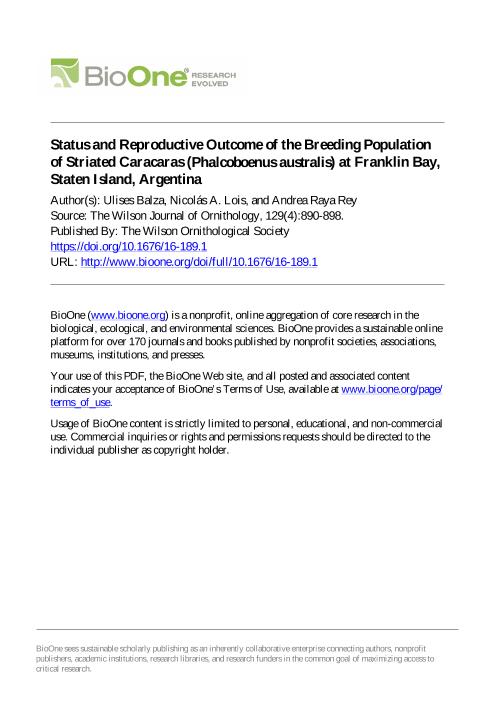Artículo
Status and Reproductive Outcome of the Breeding Population of Striated Caracaras (Phalcoboenus australis) at Franklin Bay, Staten Island, Argentina
Fecha de publicación:
12/2017
Editorial:
Wilson Ornithological Society
Revista:
Wilson Journal of Ornithology
ISSN:
1559-4491
Idioma:
Inglés
Tipo de recurso:
Artículo publicado
Clasificación temática:
Resumen
The Striated Caracara (Phalcoboenus australis) is a poorly known raptor associated with seabird colonies, restricted to the islands of southern South America, and with an estimated extant population of <2,500 mature individuals. We evaluated the number of breeding pairs, described the characteristics and spatial pattern of nest sites, and estimated breeding output of a population of Striated Caracaras in Franklin Bay, Staten Island, Argentina. We found one of the lower breeding density values reported for this species, although this population is associated with one of the biggest colonies of Rockhopper Penguins. The main material used for the construction of Striated Caracaras' nests was tussac grass, though only half of nests were placed in grassland. The spatial pattern for nest sites corresponds with global and local clustering. All successful Striated Caracaras' nests were at least 250 m from the nearest neighboring nest, were generally closer to the colony of Rockhopper Penguins than failed nests, and had more Rockhopper patches around them. Breeding success was 0.73 successful nests/active nests, productivity was 1.27 ± 1.01 young/active nest, and brood size was 1.75 ± 0.71 young/successful nest. The presence of invasive wild goats and red deer is proposed as a factor that could be restricting nest site availability in the study area.
Palabras clave:
Breeding Output
,
Invasive Species
,
Nest Site Availability
,
Spatial Analysis
Archivos asociados
Licencia
Identificadores
Colecciones
Articulos(CADIC)
Articulos de CENTRO AUSTRAL DE INVESTIGACIONES CIENTIFICAS
Articulos de CENTRO AUSTRAL DE INVESTIGACIONES CIENTIFICAS
Citación
Balza, Ulises; Lois, Nicolás Alejandro; Raya Rey, Andrea Nélida; Status and Reproductive Outcome of the Breeding Population of Striated Caracaras (Phalcoboenus australis) at Franklin Bay, Staten Island, Argentina; Wilson Ornithological Society; Wilson Journal of Ornithology; 129; 4; 12-2017; 890-898
Compartir
Altmétricas




